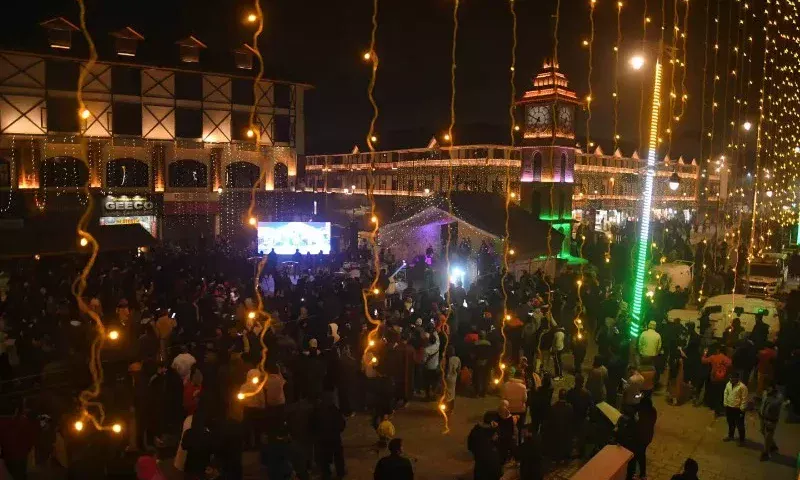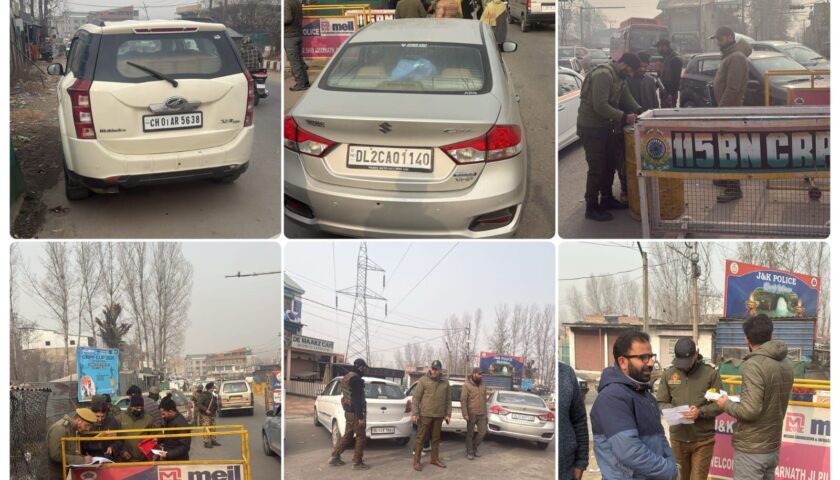Security personnel patrolling the roads and checking vehicles is not an unusual sight for Kashmir. But to see them making drivers and passengers alight on Kanidajan road near Yusmarg — Kashmir’s famous tourist resort — on a recent morning came after a long time.
Some of the personnel had taken positions along the snow-covered road and under the pine trees, while others stopped vehicles and wrote down their registration numbers, names and contact numbers of owners.
The checking on Kanidajan road has been going on since last week, after forces killed four Jaish-e-Mohammad (JeM) militants in the nearby Futlipora area, on 30 November, while people of adjoining villages including Kanidajan and Pakherpora hit the roads and tried to disrupt the anti-militancy operation.
An 11th class student, Sameer Ahmad, who lives in Yusmarg, said that the force personnel were not resorting to frisking and this had happened only after the anti-militancy operation at Futlipora. The curbs had followed only after the encounter. On the day the militants engaged in a gunfight with forces, he was not allowed to go for studies at the higher secondary school in Pakherpora.
“It was a peaceful area, but now the searches have become common,’ said Sameer. as he walked towards his house on the Pakherpora road with his friends. On 19 December, the forces engaged with militants a few kilometres away at Bhatmuran in Shopian. Two JeM militants and a woman were killed while several youths were injured in the protests near the encounter site. That day, the movement of traffic was thin in Pakherpora while areas of Rohmoo and Pulwama remained shut.
In Kashmir, the forces have taken additional security measures to contain militancy. Apart from noting down the vehicle numbers, the armed forces have also started numbering of houses in Kashmir to keep a tab on the movement of militants and over ground workers (OGWs). Defence spokesman Colonel Rajesh Kalia said that the “house numbering and noting down of vehicle numbers were for the maintenance of records.”
Since July 2016, after the killing of Hizbul Mujahideen militant commander Burhan Muzafar Wani, the discourse in Kashmir has changed from demilitarisation to less lethal means of crowd control by stopping the use of pellet guns and weaning away youth to the mainstream.
Over 100 youths have joined militant ranks this year, the highest number in recent years. In the previous coalition governments, led by former chief ministers Omar Abdullah and Ghulam Nabi Azad, the state government had taken up the issue of reducing the number of troops in Kashmir.
Azad was looking at reducing the numbers to pre-1989 level in Kashmir when militancy had not erupted. However, security officials have taken to additional measures and the cordon and search operations (CASO) have again become a routine affair in Kashmir.
The separatists and human rights activists maintain that the deployment of forces in Kashmir was one of the highest and nearly seven lakh troops were stationed here. However, officials said that the troop strength was relatively lower and there was a deployment of four divisions of the army in Kashmir, besides nearly 50 battalions of paramilitary forces.
However, additional security checks, especially during the night time, has restricted the movement of people on the roads. Across Kashmir, the force personnel have taken to night-time patrolling which has curbed the movement of people. Night travel has become nearly impossible as shops and business establishments get closed in the evening hours and people prefer to remain indoors. They travel at night only in case of a medical emergency.
The sudden appearance of gun-wielding personnel at checking points by dusk has gained intensity here. On the roads, the force personnel suddenly put on torch lights and the vehicles are thoroughly checked. The drivers are made to turn off the headlights of vehicles and only allowed to use sidelights till they are out of sight of the security barricade.
Such measures are even applied to areas which have not witnessed any major militancy operations. Frequent night patrolling is being carried out Chadoora, Budgam and Bag-i-Mehtab areas of central Kashmir while it remains in place in southern and northern parts of Kashmir.
On 18 December, a driver named Asif Iqbal Bhat was killed at Thandipora in frontier district of Kupwara during a late night army ambush. He had stepped out of his home to ferry a passenger to a hospital and was hit by a bullet as he put on the light of his cell phone. A senior security official said that the army was carrying out patrolling in Thandipora area as militants keep on infiltrating from across the line of control (LoC) there, which is only at a distance of 10-12 kilometres.
“The area is a heavy infiltration route. Earlier a fidayeen attack took place in 2016 on a forces camp in Panzgam after militants had infiltrated from across the LoC,” said a senior police official. He said that Asif was killed at around 10:30 pm as he received a call on his cell phone to pick up a passenger from a nearby area. “A patrolling was going on in the area,” added the official.
Former president of Kashmir Chamber of Commerce and Industries, Mushtaq Ahmad Wani, said that the “prevailing security situation has resulted into heavy losses to businesses”.
The existing circumstances have turned many businesses financially unviable. Shops have to be closed early evening while the factories also get shut,’’ he said.




